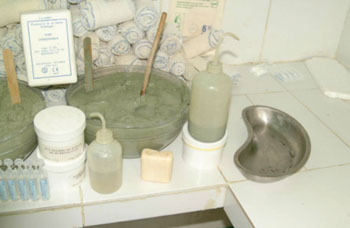Clay Preparations Destroy Antibiotic-Resistant Bacteria
By HospiMedica International staff writers
Posted on 30 Jul 2014
Natural clay deposits with antibacterial properties could provide a possible solution for killing pathogens resistant to multiple antibiotics.Posted on 30 Jul 2014
Researchers at Arizona State University (ASU; Phoenix, USA) set out to identify naturally-occurring clays that are effective at killing antibiotic-resistant bacteria. The scientists examined mineralized clay deposits near Crater Lake (OR, USA), in an area mined by Oregon Mineral Technologies (OMT; Jackson, USA). The clay, formed by volcanic activity millions of years ago, had turned into bluish clay known as K Rectorite. The clay contains over 40 minerals, including silicon, aluminum, iron, potassium, magnesium, calcium, sodium, manganese, sulfur, and phosphate.

Image: French green clays used for healing Buruli ulcers (Photo courtesy of Thierry Brunet de Courssou/ASU).
The researchers hypothesized that the clays buffer pH (acidity)and Eh (oxidation) to dissolve unstable mineral phases containing transition metals (primarily Fe2+), while smectite interlayers serve as reservoirs for time release of bactericidal components. They then incubated the pathogens Escherichia coli and Staphylococcus epidermidis with clays from different zones. They found that rapid uptake of Fe2+ impaired bacterial metabolism by flooding the cell and overwhelming iron storage proteins. As the intracellular Fe2+ oxidized, it produced reactive oxygen species that damage biomolecules and precipitates Fe-oxides. The study was published in the August 2014 issue of Environmental Geochemistry and Health.
“As antibiotic-resistant bacterial strains emerge and pose increasing health risks, new antibacterial agents are urgently needed. Antibacterial clays may shift the wound environment to a pH range that favors healing, while killing invading bacteria,” said senior author biogeochemist Lynda Williams, PhD. “The ability of antibacterial clays to buffer pH also appears key to their healing potential and viability as alternatives to conventional antibiotics.”
Green clays, historically used in France in mineral baths, have been used to treat Mycobacterium ulcerans, the pathogen that causes Buruli ulcers. The infections, which lead to the destruction of skin and large, open ulcers on arms or legs, can be treated with daily applications of green clay poultices to heal the infections. Unfortunately, the original French green clays have been depleted, and later testing of newer samples did not show the same results.
Related Links:
Arizona State University
Oregon Mineral Technologies














